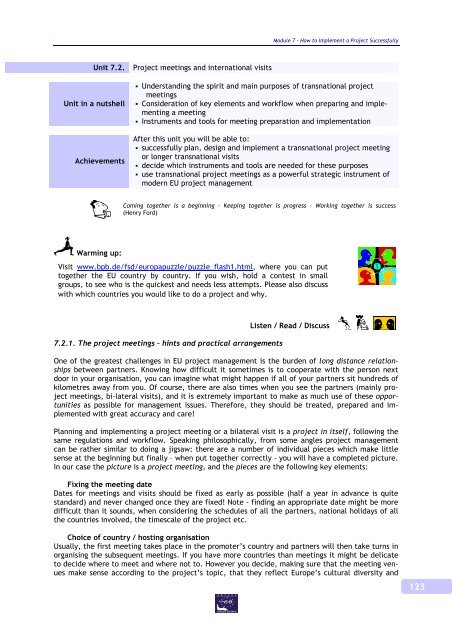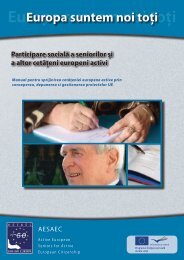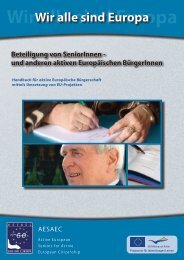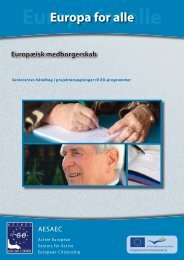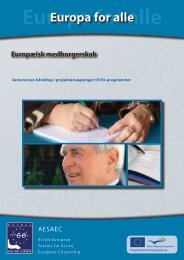We All are Europe - AESAEC
We All are Europe - AESAEC
We All are Europe - AESAEC
Create successful ePaper yourself
Turn your PDF publications into a flip-book with our unique Google optimized e-Paper software.
Module 7 – How to Implement a Project Successfully<br />
Unit 7.2.<br />
Unit in a nutshell<br />
Achievements<br />
Project meetings and international visits<br />
Understanding the spirit and main purposes of transnational project<br />
meetings<br />
Consideration of key elements and workflow when preparing and implementing<br />
a meeting<br />
Instruments and tools for meeting preparation and implementation<br />
After this unit you will be able to:<br />
successfully plan, design and implement a transnational project meeting<br />
or longer transnational visits<br />
decide which instruments and tools <strong>are</strong> needed for these purposes<br />
use transnational project meetings as a powerful strategic instrument of<br />
modern EU project management<br />
Coming together is a beginning - Keeping together is progress - Working together is success<br />
(Henry Ford)<br />
Warming up:<br />
Visit www.bpb.de/fsd/europapuzzle/puzzle_flash1.html, where you can put<br />
together the EU country by country. If you wish, hold a contest in small<br />
groups, to see who is the quickest and needs less attempts. Please also discuss<br />
with which countries you would like to do a project and why.<br />
7.2.1. The project meetings – hints and practical arrangements<br />
Listen / Read / Discuss<br />
One of the greatest challenges in EU project management is the burden of long distance relationships<br />
between partners. Knowing how difficult it sometimes is to cooperate with the person next<br />
door in your organisation, you can imagine what might happen if all of your partners sit hundreds of<br />
kilometres away from you. Of course, there <strong>are</strong> also times when you see the partners (mainly project<br />
meetings, bi-lateral visits), and it is extremely important to make as much use of these opportunities<br />
as possible for management issues. Therefore, they should be treated, prep<strong>are</strong>d and implemented<br />
with great accuracy and c<strong>are</strong>!<br />
Planning and implementing a project meeting or a bilateral visit is a project in itself, following the<br />
same regulations and workflow. Speaking philosophically, from some angles project management<br />
can be rather similar to doing a jigsaw: there <strong>are</strong> a number of individual pieces which make little<br />
sense at the beginning but finally – when put together correctly - you will have a completed picture.<br />
In our case the picture is a project meeting, and the pieces <strong>are</strong> the following key elements:<br />
Fixing the meeting date<br />
Dates for meetings and visits should be fixed as early as possible (half a year in advance is quite<br />
standard) and never changed once they <strong>are</strong> fixed! Note - finding an appropriate date might be more<br />
difficult than it sounds, when considering the schedules of all the partners, national holidays of all<br />
the countries involved, the timescale of the project etc.<br />
Choice of country / hosting organisation<br />
Usually, the first meeting takes place in the promoter’s country and partners will then take turns in<br />
organising the subsequent meetings. If you have more countries than meetings it might be delicate<br />
to decide where to meet and where not to. However you decide, making sure that the meeting venues<br />
make sense according to the project’s topic, that they reflect <strong>Europe</strong>’s cultural diversity and<br />
123


